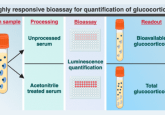Assay could predict suspect’s gender at the scene of a crime

Researchers develop colorimetric assay to identify gender from blood samples.
Collaborators from Clarkson University (NY, USA) and the University at Albany (NY, USA) have recently published research on a novel assay for gender identification. The assay measures the levels of two enzymes that are found to differ between male and female subjects.
The assay was developed with forensic applications in mind, with the simple and fast method envisioned to be used on-site at crime scenes. Blood samples were analyzed for levels of the two enzymes via a colorimetric assay. As the authors explain, use of the chromogenic agent nitroblue tetrazolium allows “qualitative discrimination of the ‘male’ and ‘female’ samples by the naked eye.”
The researchers found that levels of enzymes creatine kinase and alanine transaminase were shown to differ between male and female samples, therefore presenting themselves as suitable biomarkers to elucidate gender. This difference, which is only small, was first amplified using a ‘multi-enzyme/multistep biocatalytic cascade.’
The team tested their assay on blood samples prepared with differing levels of creatine kinase and alanine transaminase, thus mimicking samples of different gender. Future work includes moving this research into real blood samples.
Source: Bakshi S, Halámková L, Halámek J, Katz E. Biocatalytic analysis of biomarkers for forensic identification of gender. Analyst 139, 559–563 (2014).






